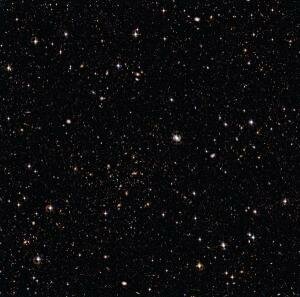A Cluster and a Sea of Galaxies
A new wide-field image released by ESO displays many thousands of distant galaxies, and more particularly a large group belonging to the massive galaxy cluster known as Abell 315.
As crowded as it may appear, this assembly of galaxies is only the proverbial "tip of the iceberg," as Abell 315 - like most galaxy clusters - is dominated by dark matter.
The huge mass of this cluster deflects light from background galaxies, distorting their observed shapes slightly.
When looking at the sky with the unaided eye, we mostly only see stars within our Milky Way galaxy and some of its closest neighbours. More distant galaxies are just too faint to be perceived by the human eye, but if we could see them, they would literally cover the sky.
This new image released by ESO is both a wide-field and long-exposure one, and reveals thousands of galaxies crowding an area on the sky roughly as large as the full Moon.
These galaxies span a vast range of distances from us. Some are relatively close, as it is possible to distinguish their spiral arms or elliptical halos, especially in the upper part of the image. The more distant appear just like the faintest of blobs - their light has travelled through the Universe for eight billion years or more before reaching Earth.
Beginning in the centre of the image and extending below and to the left, a concentration of about a hundred yellowish galaxies identifies a massive galaxy cluster, designated with the number 315 in the catalogue compiled by the American astronomer George Abell in 1958. The cluster is located between the faint, red and blue galaxies and the Earth, about two billion light-years away from us. It lies in the constellation of Cetus (the Whale).
Galaxy clusters are some of the largest structures in the Universe held together by gravity. But there is more in these structures than the many galaxies we can see.

"The Cluster of Galaxies Abell 315: This wide-field, deep image reveals thousands of galaxies crowding an area on the sky roughly as large as the full Moon. (Credit: ESO/J. Dietrich)"
Source: European Southern Observatory
|